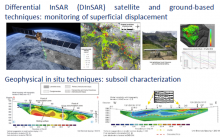Research seminar on geotechnics
Title: Geophysical methods for landslide investigation
Angela Perrone, PhD
Researcher at the Institute of Methodologies for Environmental Analysis (IMAA) of the Italian National Research Council (CNR)
Abstract:
Landslides are complex geological phenomena characterized by a high complexity and variability in space and time. Their investigation usually requires a multidisciplinary approach based on the integration of satellite, airborne and ground-based sensing technologies. Each technique allows the study of specific triggering factors and/or particular physical features, characterizing the landslide body compared with the material not affected by the movement.
Remote sensing methods (i.e. digital aerophotogrammetry, GPS, Lidar, differential interferometric SAR, etc.) are usually applied to obtain information on the surface characteristics of the investigated slope, such as geomorphological features, the areal extension of the landslide body, superficial displacement and velocity, without giving any information on subsoil characteristics.
Direct ground-based techniques (i.e. piezometer, inclinometer, laboratory tests, etc.) provide true information on the mechanical and hydraulic properties of the terrains affected by the landslide but in a specific point of the subsoil.
In situ geophysical techniques (electromagnetic, seismic, etc.) are able to measure physical parameters directly or indirectly linked with the lithological, hydrological and geotechnical characteristics of the terrains related to the movement. These techniques are less invasive then the previous ones and provide information integrated on a greater volume of the soil.
The combination of the products obtained by applying all the previous techniques greatly enhances the knowledge of the phenomenon investigated. Moreover, it also guarantees the validation of indirect products (by remote sensing and geophysical methods) by using direct data; this validation is still required for the correct interpretation of indirect data/products despite in the last years new technologies for their acquisition and inversion algorithms for their processing have been developed.


